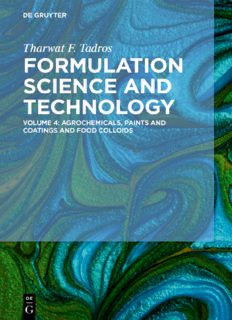
Formulation Science and Technology: Volume 4: Agrochemicals, Paints and Coatings and Food Colloids PDF
Preview Formulation Science and Technology: Volume 4: Agrochemicals, Paints and Coatings and Food Colloids
TharwatF.Tadros FormulationScienceandTechnology Also of Interest HandbookofColloidandInterfaceScience. Volumes1–4 Tadros,2018 ISBN978-3-11-054050-5 SuspensionConcentrates. Preparation,StabilityandIndustrialApplications Tadros,2017 ISBN978-3-11-048678-0,e-ISBN978-3-11-048687-2 PolymericSurfactants. DispersionStabilityandIndustrialApplications Tadros,2017 ISBN978-3-11-048722-0,e-ISBN978-3-11-048728-2 Formulations. InCosmeticandPersonalCare Tadros,2016 ISBN978-3-11-045236-5,e-ISBN978-3-11-045238-9 Emulsions. Formation,Stability,IndustrialApplications Tadros,2016 ISBN978-3-11-045217-4,e-ISBN978-3-11-045224-2 Tharwat F. Tadros Formulation Science and Technology | Volume 4: Agrochemicals, Paints and Coatings and Food Colloids Author Prof.TharwatF.Tadros 89NashGroveLane WorkinghamRG404HE Berkshire,UK [email protected] ISBN978-3-11-058755-5 e-ISBN(PDF)978-3-11-058800-2 e-ISBN(EPUB)978-3-11-058756-2 LibraryofCongressControlNumber:2018935454 BibliographicinformationpublishedbytheDeutscheNationalbibliothek TheDeutscheNationalbibliothekliststhispublicationintheDeutscheNationalbibliografie; detailedbibliographicdataareavailableontheInternetathttp://dnb.dnb.de. ©2018WalterdeGruyterGmbH,Berlin/Boston Coverimage:Nik_Merkulov/iStock/GettyImages Typesetting:PTP-Berlin,Protago-TEX-ProductionGmbH,Berlin Printingandbinding:CPIbooksGmbH,Leck www.degruyter.com Preface This volume describes industrial applications in agrochemicals (Part I), paints and coatings(PartII)andfoodcolloids(PartIII).Thediscussionofagrochemicalformula- tionsbeginswithageneralintroduction(Chapter1)describingtherequirementsofthe varioustypesofsystems.ThisisfollowedbyChapter2,whichfocusesonemulsifiable concentrates(ECs),inwhichtheactiveingredientismixed(ordissolved)inanoiland twosurfactants.Whenthisoilisaddedtoanaqueoussolutioninthespraytank,it spontaneously emulsifies forming an oil/water (O/W) emulsion. The mechanism of self-emulsificationisdescribed.TheseECsarenowmostlyreplacedwithaconcen- tratedO/Wemulsion(Chapter3),whichprovidesanumberofadvantages,suchas usinglessoilandsurfactantandthepossibilityofincorporatinganadjuvant(which enhancesthebiologicalefficacy)inthecontinuousphase.Chapter4dealswiththe formulationofsuspensionconcentrates(SCs),whicharecommonlyusedtoreplace wettablepowders(whichcanbedustyandhazardoustotheoperator).Themainfac- torsinvolvedinSCformulationanditslong-termphysicalstabilityaredescribedwith particularreferencetotherheologicalmethodsthatcanbeappliedfortheirassess- ment.Chapter5describestheformulationofoil-basedsuspensions,wherebytheoil canbepolarornonpolar.Therequirementsforbothtypestoachievecolloidstability aredescribedandthisisfollowedbyadescriptionoftheuseofanti-settlingsystems innonaqueoussuspensions.Finally,theemulsificationoftheoil-basedsuspensionin aqueousandelectrolytesolutionmediaisdescribed.Chapter6describestheformu- lationofsuspoemulsions(mixturesofsuspensionsandemulsions)highlightingthe possible interactions between the suspension particles and the emulsion droplets. This can lead to various instability problems such as homoflocculation, heterofloc- culation, coalescence of emulsion droplets and recrystallization. The methods that can be used to reduce or eliminate such instabilities are described with particular referencetopolymericsurfactants.Chapter7dealswiththeformulationofcontrolled- releasesystemswithparticularreferencetothemicroencapsulationofliquidandsolid AIs,controlledreleasefrommatrix-basedmicroparticlesandgranules.Chapter8de- scribestheformulationofadjuvantsthatarerequiredtoenhancethebioefficacyofthe AISeveralfactorsmustbeconsideredwhenselectinganadjuvantforagivenAIThese include interactions at the air/water interface and their effect on spray droplet for- mation,sprayimpactionandadhesion,wettingandspreading,evaporationofspray dropletsandformationofdeposits,solubilisationoftheAIbysurfactantmicellesand itseffectontransportandinteractionbetweenagrochemical,surfactantsandtarget species. PartIIdealswiththeformulationofpaintsandcoatings.Chapter9describesthe natureofthedispersedparticle,thedispersionmediumandfilmformers,thedepo- sitionofparticlesandtheiradhesiononsubstratesandtheflowcharacteristics(rhe- ology)ofthepaintformulation.Chapter10describestheformulationoffilmformers https://doi.org/10.1515/9783110588002-001 vi | Preface usingemulsionanddispersionpolymerization.Chapter11dealswiththeformulation ofpigmentsforpaintapplication.Topicssuchasthewettingofpowders,breakingof aggregatesandagglomerates,wetmillingandcolloidstabilizationofthepaintdis- persionmustbeconsidered.Chapter12describestheprocessofenhancingparticle depositionanditsfinaladhesion.Thisisgovernedbylong-rangeforcessuchasdouble layerrepulsion(orattraction)andshort-range(surfaceforces).Chapter13illustrates the rheological techniques that can be applied during paint formulation, whereas Chapter14showshowtheserheologicalmethodscanbeappliedduringpaintformu- lation.Chapter15givesexamplesoftheflowpropertiesofsomecommercialpaints. PartIIIdescribestheformulationoffoodcolloids.Itstartswithageneralintroduc- tion(Chapter16)highlightingthecomplexityoffoodsystems.Chapter17startswith adescriptionoftheinteractionbetweenfoodgradesurfactantsandthestructureof theliquidcrystallinephases.Thisisfollowedbyadescriptionofbinaryandtertiary phasediagrams,monolayerformationandtherelationshipbetweentheliquidcrys- tallinestructureandemulsionstability.Chapter18dealswiththeformulationoffood emulsionsusingproteins,protein/polysaccharideandsurfactant/polysaccharidein- teractions. The structure of portents and their interaction and conformation at the liquid/liquidinterfacearedescribed.Chapter19describestheprocessofsurfactant associationstructures,microemulsionsandemulsionsinfood.Chapter20dealswith therheologyoffoodemulsionswithparticularreferencetointerfacialandbulkrheol- ogy.Thecorrelationbetweeninterfacialrheologyandemulsionstabilityishighlighted usingtwoexamples,namelymixedsurfactantandproteinfilms.Thebulkrheologyof emulsionsisdescribedwithparticularreferencetomicrogeldispersionsandthefrac- talnatureoftheaggregatednetwork.Chapter21dealswithfoamformulationsinfood ofwhichwhippingcreamandbreaddougharethemostcommon.Inthefirstcase,the airbubblesarestabilizedbyfatcrystalsthatadheretoairbubblesduringthewhipping process forming a protective layer and preventing bubble coalescence. In the latter case,thebreadqualityisdeterminedbyahighbreadvolumeandafinecrumbstruc- ture.Severaltheorieshavebeenproposedtoexplainfoamstability,namely:surface viscosityandelasticitytheory,wheretheadsorbedsurfactantfilmisassumedtocon- trolthemechanical-dynamicalpropertiesofthesurfacelayersbyvirtueofitssurface viscosityandelasticity;theGibbs–Marangonieffecttheory;surfaceforcestheory(dis- joiningpressureπ),whichoperatesunderstatic(equilibrium)conditionsinrelatively dilute surfactant solutions (h < 100nm); stabilisation by micelles (high surfactant concentrations >cmc); stabilization by lamellar liquid crystalline phases, which is particularlythecasewithnonionicsurfactantsthatproducelamellarliquidcrystalline structureinthefilmbetweenthebubbles;stabilisationoffoamfilmsbymixedsurfac- tantswherebyacombinationofsurfactantsgiveslowerdrainageandimprovedfoam stability;andstabilizationbysolidparticles,whichinvolvesparticlesadsorbingatthe air/liquidinterface.Chapter22looksattherelationshipbetweenrheologyandmouth feel.Afterdescribingthemainrheologicalmeasurementsthatneedtobeappliedto obtainsuchacorrelation,someemphasisisgiventothebreak-upofNewtonianand Preface | vii non-Newtonian liquids. The complexity of flow in the oral cavity is described and subsequentlyadescriptionisgivenoftherelationshipbetweentextureandrheology. Finally,someexamplesofpracticalfoodcolloidsaregiven. Thisbook(Volume4)givesanumberofformulationexamplesintheareasofagro- chemicals,paintsandcoatingandfoodcolloids.Itisavaluabletextforformulation scientistsinvolvedintheformulationofthesesystems.Itmayalsobeusefulforaca- demicsinvolvedinaresearcharearelatedtoanyoftheseformulations. TharwatTadros May2018 Contents Preface|v PartI:Theformulationofagrochemicals 1 Introductiontotheformulationofagrochemicals|3 2 Formulationofemulsifiableconcentrates|9 3 Formulationofemulsionconcentrates|15 3.1 Formationofemulsions|15 3.2 Mechanismsandmethodsofemulsification|16 3.3 Roleofsurfactantsinemulsionformation|18 3.4 Selectionofemulsifiers|20 3.4.1 Hydrophilic–lipophilicbalanceconcept|20 3.4.2 Phaseinversiontemperatureconcept|23 3.5 Emulsionstability|25 4 Formulationofsuspensionconcentrates|35 4.1 Introduction|35 4.2 Preparationofsuspensionconcentrates andtheroleofsurfactants/dispersingagents|36 4.3 Controlofthephysicalstabilityofsuspensionconcentrates|40 4.4 Characterizingsuspensionconcentratesandassessing oftheirlong-termphysicalstability|50 5 Oil-basedsuspensionconcentrates|59 5.1 Introduction|59 5.2 Stabilityofnonaqueoussuspensions|59 5.3 Emulsificationofoil-basedsuspensions|66 5.4 Polymericsurfactantsforoil-basedsuspensionsandthechoice ofemulsifiers|68 5.5 Emulsificationintoaqueouselectrolytesolutions|69 5.6 Properchoiceofanti-settlingsystem|69 5.7 Rheologicalcharacteristicsofoil-basedsuspensions|70 6 Formulationofsuspoemulsions|71 6.1 Introduction|71 6.2 Suspoemulsionsinvestigated|72
Description: